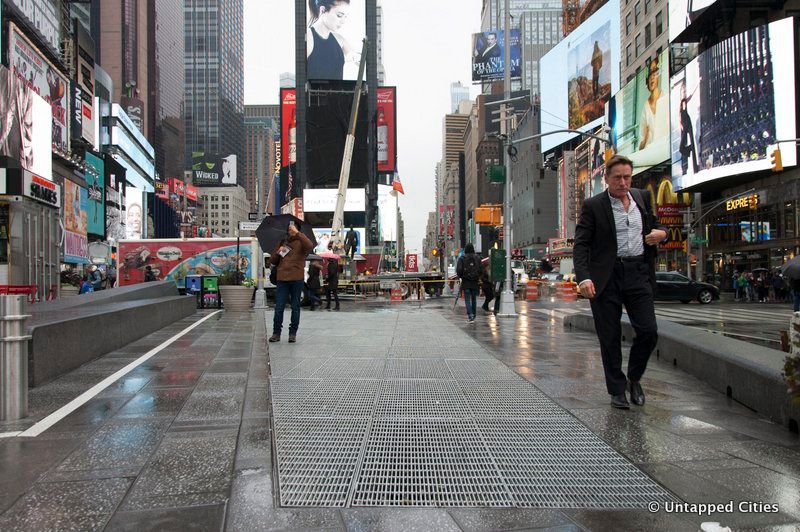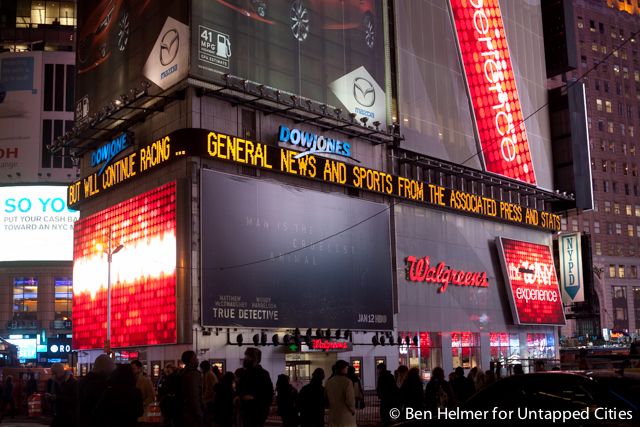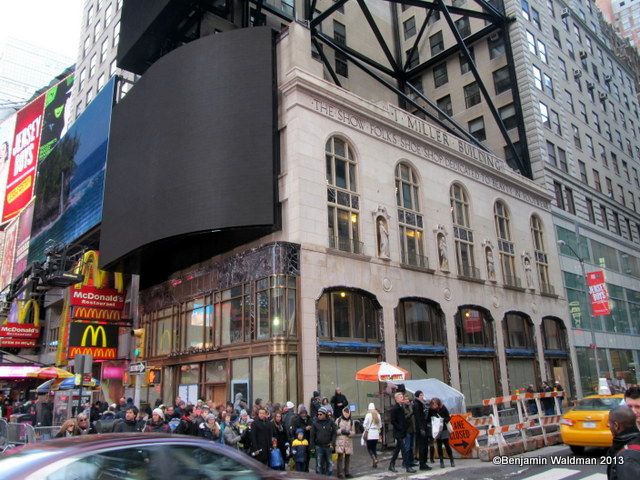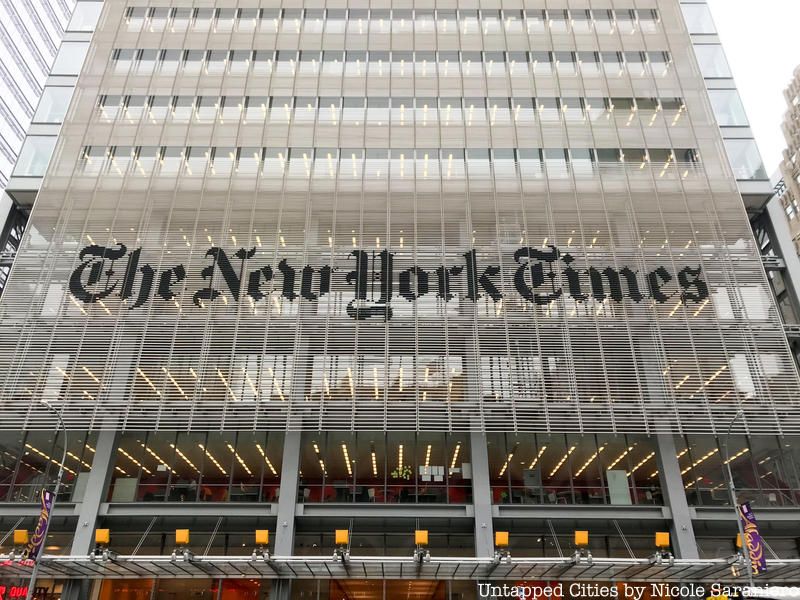How to Make a Subway Map with John Tauranac
Hear from an author and map designer who has been creating maps of the NYC subway, officially and unofficially, for over forty years!


Times Square may be the most touristy spot in New York City, and one that New Yorkers avoid at all costs. But we thought it might be time to shed some new light on the much-maligned landmark. Here are our 10 favorite secrets about Times Square:

Some would accurately describe Max Neuhaus as a “sound sculptor.” His installation, “Times Square” below the subway ventilation grates on a slab of land between Broadway and 7th Avenues (45th & 46th Street) has been a little-known attraction since 1977, emanating huge sound to the select few who purposely or accidentally experience it.
The late percussionist had this to say about his installation in 2002, “The piece isn’t meant to startle, it’s meant for people who are ready to discover. In fact, I never do a work where everybody stops and notices it in a public place. I want at least 50% of the people to walk through it without noticing it, without hearing it.” This unpretentious find goes down as one of our top 10 subway art installations in NYC.

As you ascend to the roof of the Walgreens Tower at 1 Times Square, you’ll see an access door. Opening it, you’re outside, a glow emanating from atop a flight of stairs. Walk up those steps, and you’re face-to-face with a New York icon: The New Years Eve Ball. Made of Waterford Crystal and LEDs, this 12-foot in diameter ball weighs nearly 12,000 pounds and is completely computer controlled. See our behind-the-scenes look at the Times Square Ball with Atlas Obscura.

When Lehman Brothers purchased One Times Square in 1995, they envisioned a new kind of tenant: advertisers. Instead of renting the offices inside the 25 floor building, they began retrofitting the facade with billboards. By 1997, the profits were up 400%, and the inside was empty.
So it remains 16 years later, hosting little more than a ground floor Walgreens and the office of Countdown Entertainment. The company, known for the New Years Eve Ball, organizes all Times Square entertainment on the last day of each year. In 2012, an appraisal note in One Time Square’s loan documents revealed its value at $495 Million, a staggering figure compared to the $27.5 million it fetched when it sold to Lehman Brothers in 1995. The New Year’s Eve ball is stored all year round inside One Times Square.
Here’s what One Times Square looked like back in the day:


On New Year’s Eve, most people probably aren’t taking a close look at the brightly colored pieces of paper falling on them—but if they did, they’d probably find a small wish written on them. That’s right—the confetti that rains down on people every New Year’s Eve contains wishes written by visitors to the Times Square Visitor Center, located between 46th and 47th Street on Seventh Avenue

Times Square is home to over 30 theaters. Sadly, many of Times Square’s opulent theaters have either been nearly gutted or completely demolished. One former theater, which is overlooked by most who visit the area, lies in the middle of that spectrum. Until recently, the former Loew’s Mayfair Theater was a souvenir store that incorporated some of the theater’s detailing. The store went out of business and so far nothing new has opened in its place. The Mayfair has a fun history too, a burlesque theater before it was a Loew’s.

The building at the northeast corner of Broadway and 46th Street is one of those hidden gems that even most New Yorkers were unaware of until recently. It had been covered by grime, billboards, and TGI Fridays signs. But all of that has changed. The façade has been cleaned, the billboards and signs are gone and the building, once the I. Miller shoe store, shines once more.
You can also see four statues representing women in the arts, modeled after clients of I. Miller. Drama is represented by Ethel Barrymore as Ophelia; Musical Comedy is represented by Marilyn Miller as Sunny; Opera is represented by Rosa Ponselle as Leonora; and Motion Pictures are represented by Mary Pickford as Little Lord Fauntleroy.

Times Square, the tourist-glutted hotspot we all know and love, was named after The New York Times in 1904 when the publication moved into its new headquarters building there to 1 Times Square. It decided to advertise with the new “spectaculars,” so called because of their large, complex light displays and intricate designs (some flashed, and some even had animated sections that moved). The show was so impressive that New Yorkers stopped celebrating New Year’s Eve at Trinity Church. The first New Year’s Eve Ball went up in 1908. The New York Times has relocated since to 8th Avenue.
Fun fact: The section of Broadway from 42nd to 53rd Street was nicknamed the Great White Way in the late 1890s, back when the street was one of the first to be fully illuminated by electric light.

1993-1998, photo by Gregoire Alessandrini
It is ironic then that the world’s arguably most commercial space used to be a haven for the city’s misfits. In the 1970s and ’80s, Times Square was haunted by prostitutes, drug dealers, and other undesirables. The stretch of 42nd Street between 7th and 8th avenues, now home to an AMC multiplex and Disney’s New Amsterdam Theater, was once lined with theaters of the pornographic variety.
Artist Nayland Blake, who curated an exhibit at the International Center of Photography on the subject last year remembers going into the Victory Theater, one of Times Square’s pleasure palaces, only to step down into the front rows of the cinema and discover that he was literally knee deep in water. The place was partially flooded and no one even bothered to pause the movie!

The pedestrian plazas, designed by Gehl Architects, were installed as part of a six-month pilot in 2009. While new Mayor Bill de Blasio has painted himself an advocate of increasing multimodal mobility, his stance when it comes to transportation and public space is not uniformly progressive. When asked “Would you take out the tables and chairs from Times Square and Herald Square and re-open Broadway?,” de Blasio answered, “I have profoundly mixed feeling on this issue. I’m a motorist myself and I was often frustrated — and then I’ve also seen on the other hand it does seem to have a positive impact on the tourist industry.”

This one is pretty obvious once you think about it. Once called Longacre Plaza, it has its triangular form thanks to the angle of Broadway. Even way back in 1836, the shape of Times Square today was already well-formed even if a lot of the land around it wasn’t developed (or flattened out) yet. Check out this cool interactive Smithsonian map which shows Manhattan in 1836 and today.
This article was written collectively by Benjamin Waldman, Ben Helmer, Alexander McQuilkin, Aby Sam Thomas, Michelle Young, Laura Itzkowitz, Kelli Trapnell, andrea marpillero-colomin and Lindsey Devers.
Subscribe to our newsletter